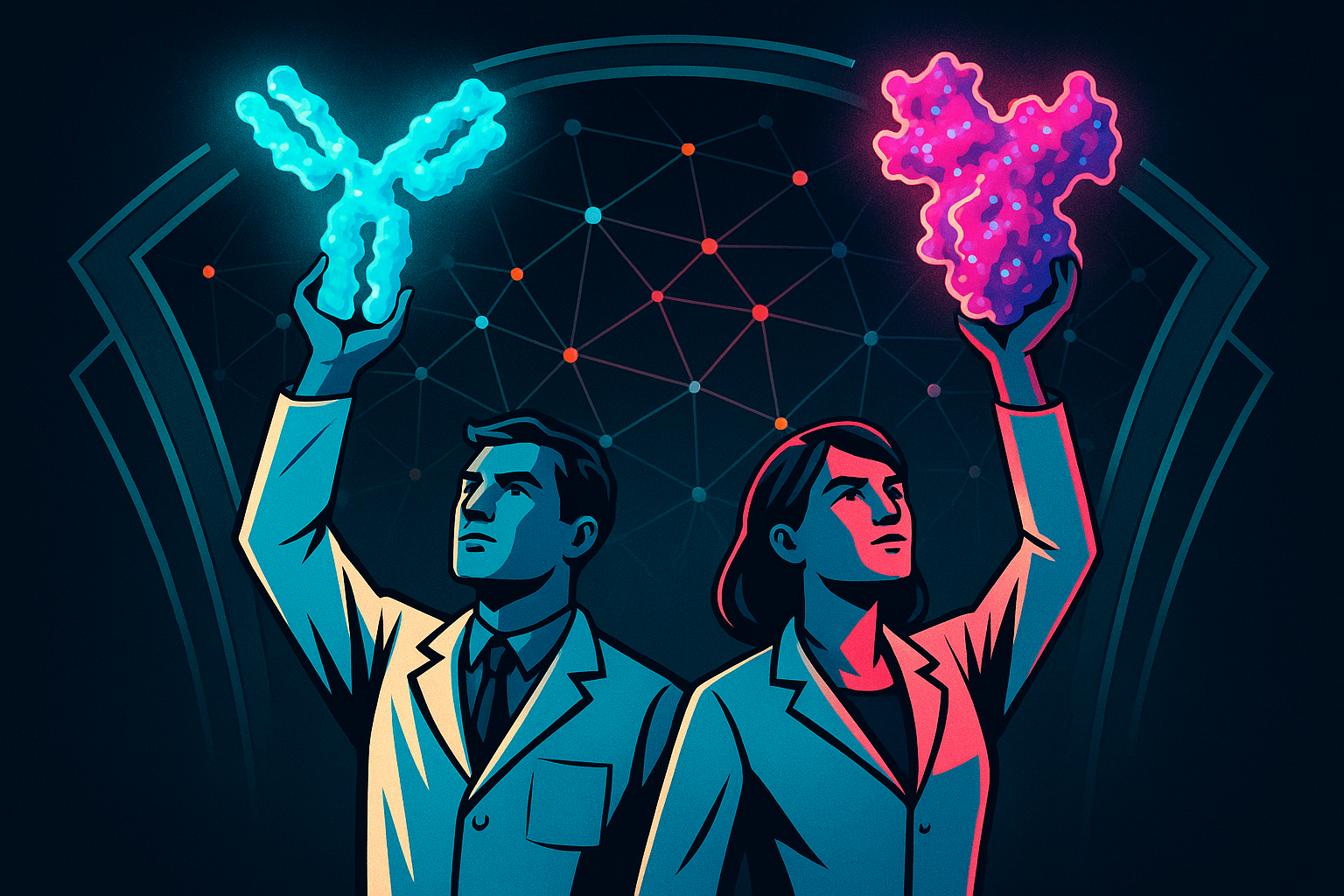AI won't revolutionize drug discovery for Big Pharma. They don't need it.
Pharma has been making remarkable biologic molecules for decades. Not just simple blockers, but a dizzying array of sophisticated therapeutics. Bispecific and multispecific antibodies. T cell engagers. "Masked" molecules that activate specifically in the tumor microenvironment. ATP- and pH-controlled antibodies. Binders to integral membrane proteins like GPCRs and ion channels. These aren't lucky accidents—they're the result of massive investments in discovery infrastructure that would make most academic departments weep with envy.
When a pharma team launches a new program, they attack from every angle. Transgenic mice churning out human antibodies. Vast phage and yeast display libraries. High-throughput screening robots testing millions of variants. Computational platforms, sure, but also good old-fashioned medicinal chemistry intuition backed by unlimited resources. Pharma can and will make a drug against any target. For them, AI drug discovery tools are just another arrow in an already overflowing quiver.
The Mirage of Faster, Cheaper Drugs
Breathless headlines promise that AI will slash drug development timelines and costs. As the legendary drug discovery blogger Derek Lowe has repeatedly pointed out, these claims consistently fall flat. Even if we could design perfect binders instantly (which we can't—yet), that barely moves the needle on what makes drug development expensive and slow.
Nearly 90% of drugs fail in clinical trials despite compelling preclinical data. AI doesn't accelerate manufacturing scale-up. It doesn't speed up the months of GLP toxicology studies. It doesn't shortcut the regulatory maze between a promising molecule and a first-in-human trial. The most elegant AI-designed protein still needs to navigate the same treacherous path from bench to bedside.
So if AI won't make drug development dramatically faster or cheaper for those who already have the tools, what's the revolution?
The Real Game Changer: Democratization
The revolution isn't about making Big Pharma more efficient. It's about giving everyone else a seat at the table.
Academic labs and small biotechs are where the truly audacious ideas emerge—the moonshots targeting novel biology that pharma considers too risky. But these groups face a maddening catch-22. Want to work with a premium antibody discovery firm? Prepare to write a check for $200,000 just to start the conversation. Oh, and sign away a slice of your future success through milestone payments and royalty stacks.
This artificial scarcity is literally the business model for many platform biotechnology companies. They guard their capabilities behind prohibitive paywalls, knowing that academic labs and startups have no other options. The result is that the most innovative therapeutic concepts—the ones that could transform how we treat disease—die on the vine because their champions can't afford the tools to prove them.
AI changes this equation completely. With tools like BindCraft available through Ariax's platform, designing functional proteins becomes a matter of hours and hundreds of dollars, not months and hundreds of thousands. No permission needed. No royalties owed. No IP entanglements. As AI leaders like Sam Altman say about the new era: "You can just do things."
From Concepts to Compounds
This shift fundamentally rewrites the economics of early-stage drug development. One of the steepest value inflection points in any therapeutic program happens at pharmacologic proof of concept—that magical moment when you prove your hypothesis actually works in a living system.
Previously, reaching this milestone required either massive institutional resources or painful compromises. I've watched brilliant researchers shelve transformative ideas simply because they couldn't access the tools to test them. The gap between "compelling hypothesis" and "testable compound" was too wide to bridge.
Now? An academic lab can go from target identification to designed binders in days. A startup can iterate through multiple approaches for the cost of a single traditional screening campaign. Most crucially, they can walk into investor meetings not with PowerPoint promises but with lead candidates much closer to the clinic.
It's not about competing with pharma on their terms. AI changes the terms entirely.
The Future Belongs to the Bold
Big Pharma has burned through hundreds of billions in R&D dollars by stampeding toward "de-risked" targets. The entire industry chases the same "validated" biology, competing to make incrementally better versions of existing drugs. It's a rational strategy when you have shareholders to please and billion-dollar infrastructure to feed.
But breakthrough medicines rarely come from playing it safe. They emerge from researchers willing to challenge dogma, to pursue mechanisms others dismiss as too speculative. These are the province of the underdogs—the academic labs and small biotechs unencumbered by institutional inertia.
AI-powered drug discovery hands these risk-takers the tools they need to prove their wild ideas actually work. We're entering an era where the limiting factor isn't the ability to make drugs, but the audacity to imagine new ones. Where a graduate student's insight can become a clinical candidate without navigating a gauntlet of platform companies and their lawyers.
In my introduction to Ariax, I asked: "What happens when anyone can make a drug?" Let me provide an answer. It means exponentially more attempts at genuine moonshots. A massive expansion of the therapeutic search space. When the barrier-to-entry collapses, conformity collapses with it. Drug discovery is about to get weirder—and that's exactly what medicine needs. AI won't make drugs 10x cheaper or deliver them 10x faster. It will make our drug pipeline 10x more innovative.
At Ariax, we're building the infrastructure for this future. Not because we think AI will make drug development easy—it won't. But because we believe the best ideas for new medicines can come from anywhere. And now, finally, anyone can act on them.
Ready to design your first protein? Fire up BindCraft on Ariax→
